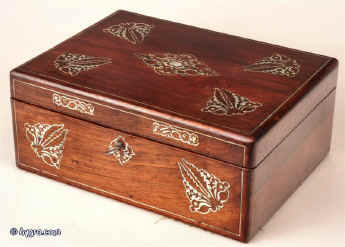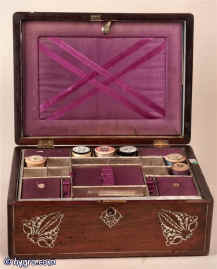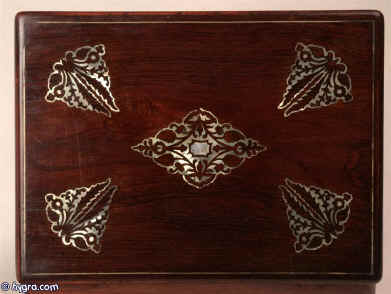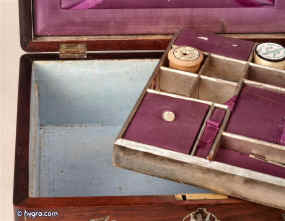Sewing
box Index

History of sewing
boxes
Request current
list of available sewing boxes
| |
Antique rosewood veneered box, inlaid with mother of pearl pattern, Circa 1840
Please click on images to enlarge | slide show | thumbnail index |
Reference: Sb118
Description:
A rosewood
veneered box, inlaid with mother of pearl in a stylized pattern, which
forms a fine foliated design in reverse having a lift out tray, still
covered with its original Tyrian purple silk with divisions
for sewing.
The
workmanship is of high standard; for example, the box is edged with a
rounded piece of wood which finishes it elegantly and also protects it.
Origin: United Kingdom
Circa: 1840
Materials: Rosewood,
mother of pearl.
Size: 30.5 cm wide by 22.6 cm by 12.7 cm:
12 inches wide
by 9 inches by 5 inches.
Condition: good
overall, working lock and key.
|

|

There is a document wallet in the lid.
|
Inside there is a liftout
tray fitted for sewing with supplementary lids covered with Tyrian
purple silk.
The fast, non-fading purple dye was an item of luxury trade, prized
by Romans,
who used it to colour ceremonial robes. Pliny
the Elder described the dyeing process of two purples in his Natural
History[2]:
"'... the Tyrian hue ... is considered of the best quality
when it has exactly the colour of clotted blood, and is of a blackish
hue to the sight, but of a shining appearance when held up to the
light; hence it is that we find Homer speaking of "purple
blood'."
From Wikipedia we learn:
"Tyrian purple (Greek:
πορφύρα,
porphura), also known as royal purple or imperial purple,
is a purple-red dye
made by the ancient Canaanites/Phoenicians
in the city of Tyre,
from a mucus-secretion of the hypobranchial gland of a marine snail
known as Murex
brandaris or the Spiny dye-murex.
A synthetic purple was not
developed untill the early 20th C.
|
Please click on images to enlarge | slide show | thumbnail index |

|
The
workmanship is of high standard; for example, the box is edged with a
rounded piece of wood which finishes it elegantly and also protects it.
|
Detail of the mother of pearl
inlay. Under magnification it is possible to see small marks indicating
that the mother of pearl inlay has been cut with a fine piercing saw.
This type of inlay is time consuming work. An interesting and
unusual feature of the inlay of this box is that the rosewood has been
engraved with fine lines depicting the veins of the leaves.
|

|
Please click on images to enlarge | slide show | thumbnail index |
Please click on images to enlarge | slide show | thumbnail index |
Please click on images to enlarge | slide show | thumbnail index |

|
A
|
Please click on images to enlarge | slide show | thumbnail index |

|
The inside of the box is lined with light blue
paper.
|
Please click on images to enlarge | slide show | thumbnail index |
All text and images and linked images are ©
1999-2007 Antigone Clarke and Joseph O'Kelly. If you require any further
information on permitted use, or a licence to republish any material, email us
at copyright@hygra.com
|
